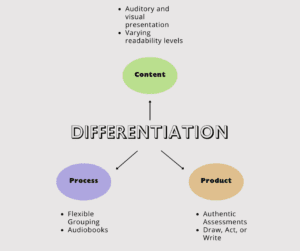As educators, we understand the importance of meeting the diverse needs of our students to create an inclusive and effective learning environment. One effective approach to achieve this is through differentiating instruction. By tailoring our teaching methods and materials to accommodate individual learning styles, abilities, and interests, we can maximize student engagement and success. If you’re looking to incorporate differentiation into your next lesson, here are three ideas to get you started.

1. Assess Prior Knowledge and Readiness Levels
Before diving into a new lesson, it’s crucial to assess your students’ prior knowledge and readiness levels. This information will help you gauge where each student stands in relation to the content you’re about to teach.
Short pre-assessments are an effective way to get the information you need. Administer a pre-assessment activity or use a brief questionnaire to determine what students already know about the topic. This will allow you to identify any gaps or misconceptions and adjust your instruction accordingly. Three easy forms of pre-assessment are:
- Quick Quiz or Questionnaire
- Entrance Ticket or Exit Slip
- Concept Mapping or KWL Chart
2. Differentiate Content, Process, and Product
Once you have a clear understanding of your students’ needs, it’s time to differentiate your instruction across three dimensions: content, process, and product. Here’s how you can approach each aspect:
Content Differentiation
Vary the materials, resources, and texts that you provide to students. Offer options that cater to different readiness levels and learning styles. Consider using leveled texts, supplemental materials, multimedia resources, or differentiated readings to meet individual needs.
Process Differentiation
Adapt your instructional strategies and learning activities to accommodate different learning preferences. Incorporate a mix of teaching methods, such as visual aids, hands-on activities, technology integration, or cooperative learning. Provide flexible grouping options, allowing students to work individually, in pairs, or in small groups as needed.
Product Differentiation
Provide students with options for demonstrating their understanding of the content. Offer a range of assessment formats, such as written essays, presentations, multimedia projects, or hands-on demonstrations. This allows students to showcase their learning in ways that align with their strengths and interests.

3. Provide Ongoing Support and Feedback
Support and feedback are essential components of differentiated instruction. Here’s how you can provide individualized support and timely feedback to foster student growth:
Individualized Support
Identify students who may require additional support and provide targeted interventions. Offer one-on-one or small group instruction to address specific needs. Collaborate with support specialists and involve parents/guardians to ensure a comprehensive support network for students.
Timely Feedback
Regularly provide constructive feedback to students to guide their progress. Be specific and actionable in your feedback, focusing on strengths and areas for improvement. Encourage self-reflection and goal setting to promote student ownership of learning. Consider using rubrics or checklists to provide clear expectations and criteria for success. Three ways to provide timely feedback are:
- Teacher-Student Conferences
- Teacher-Small Group Conferences
- Online Applications such as Turnitin, Google Classroom, that allow you to instantly send feedback
By incorporating these three tips into your instructional practices, you’ll be well on your way to differentiating instruction effectively in your next lesson. Remember to assess prior knowledge, differentiate content, process, and product, and provide ongoing support and feedback. By catering to the individual needs of your students, you’ll create a dynamic and inclusive learning environment that maximizes student engagement and success.
